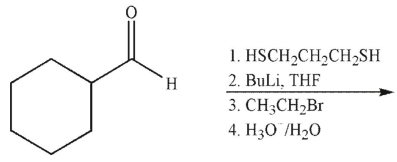Correct Answer

verified
11eb4b6a_e197_ca96_80d3_2d33a44298ce_TB4310_00
Correct Answer
verified
Essay
Devise a multistep synthesis for the following transformation. Show the reagents needed for each step and the product of each step. Do not draw any mechanisms.

Correct Answer

verified
Correct Answer
verified
Essay
Devise a multistep synthesis for the following transformation.Show the reagents needed for each
step and the product of each step.Do not draw any mechanisms. 
Correct Answer

verified
11eb4b6a_e198_18be_80d3_35d730b8d58b_TB4310_00
Correct Answer
verified
Multiple Choice
What is the product of the following reaction sequence? 
A) ![]()
B) ![]()
C) ![]()
D) ![]()
E) ![]()
Correct Answer

verified
Correct Answer
verified
Multiple Choice
Which of the following compounds is the weakest acid?
A) ![]()
B) ![]()
C) ![]()
D) ![]()
E) ![]()
Correct Answer

verified
Correct Answer
verified
Multiple Choice
What would be the product of the following reaction sequence?

A) ![]()
B) ![]()
C) ![]()
D) ![]()
E) ![]()
Correct Answer

verified
Correct Answer
verified
Multiple Choice
What is the final product of this reaction sequence? 
A) ![]()
B) ![]()
C) ![]()
D) ![]()
E) ![]()
Correct Answer

verified
Correct Answer
verified
Essay
Show the mechanism of the reaction that acetone undergoes in the presence of aqueous base. 
Correct Answer

verified
Correct Answer
verified
Multiple Choice
What would be the expected product of the following synthetic sequence? 
A) ![]()
B) ![]()
C) ![]()
D) ![]()
E) ![]()
Correct Answer

verified
Correct Answer
verified
Essay
Devise a multistep synthesis for the following transformation.Show the reagents needed for each
step and the product of each step.Do not draw any mechanisms. 
Correct Answer

verified
Correct Answer
verified
Multiple Choice
What is the product of the following transformation? 
A) ![]()
B) ![]()
C) ![]()
D) ![]()
E) Either a or b is possible.
Correct Answer

verified
Correct Answer
verified
Multiple Choice
What is the final product of the following reaction sequence? 
A) ![]()
B) ![]()
C) ![]()
D) ![]()
E) ![]()
Correct Answer

verified
E
Correct Answer
verified
Essay
Draw the product of the following reaction.

Correct Answer

verified
Correct Answer
verified
Multiple Choice
Which of the following is the correct product of the reaction conditions shown? 
A) ![]()
B) ![]()
C) ![]()
D) ![]()
E) ![]()
Correct Answer

verified
Correct Answer
verified
Multiple Choice
What are the starting materials needed to make the molecule shown using an aldol condensation? 
A) ![]()
B) ![]()
C) ![]()
D) ![]()
E) ![]()
Correct Answer

verified
Correct Answer
verified
Multiple Choice
Which of the following is a thermodynamic enolate?
A) ![]()
B) ![]()
C) ![]()
D) ![]()
E) ![]()
Correct Answer

verified
Correct Answer
verified
Essay
Provide a mechanism for the following transformation. 
Correct Answer

verified
Correct Answer
verified
Multiple Choice
What is the product of the reaction conditions shown? 
A) ![]()
B) ![]()
C) ![]()
D) ![]()
E) None of these structures is the product of the reaction conditions shown.
Correct Answer

verified
Correct Answer
verified
Multiple Choice
Which of the following is the correct product of the conditions shown?

A) ![]()
B) ![]()
C) ![]()
D) ![]()
E) ![]()
Correct Answer

verified
Correct Answer
verified
Essay
Provide a mechanism for the following transformation. 
Correct Answer

verified
Correct Answer
verified
Showing 1 - 20 of 71
Related Exams